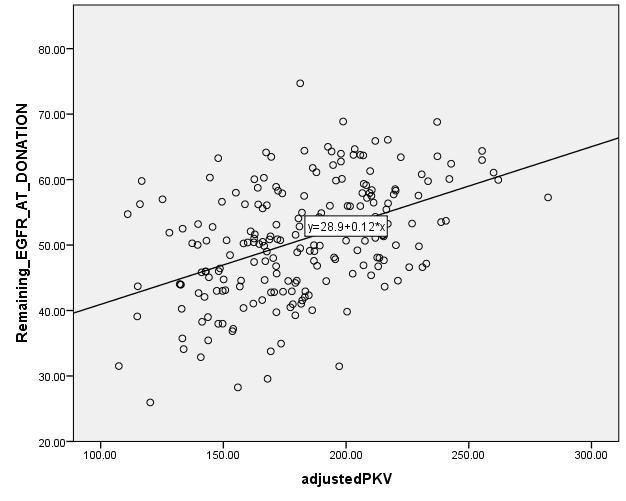Functional Gain in eGFR Among Living Kidney Donors and Its Association with Remaining Kidney Volume.
Indiana University Health, Indianapolis
Meeting: 2017 American Transplant Congress
Abstract number: A238
Keywords: Donation, Nephron mass, Renal function
Session Information
Session Name: Poster Session A: Living Donor Kidney Transplant I
Session Type: Poster Session
Date: Saturday, April 29, 2017
Session Time: 5:30pm-7:30pm
 Presentation Time: 5:30pm-7:30pm
Presentation Time: 5:30pm-7:30pm
Location: Hall D1
Background:CT volumes have good correlation with nuclear imaging to measure split renal function. Kidney volume can be a surrogate marker for nephron mass. Our objectives were to study the correlations of remaining kidney volume (aPKV) with pre-donation and 2 year functional gain post donation eGFR measurements (CKD-EPI).
Methods: We reviewed the donor radiological and pre and post- donation data from 2008 to 2012. 208 donors (63.9% F; mean age 40.6±10.5; 92.3% Whites). Remaining Kidney (RK)eGFR was calculated by measuring split volume difference between donated and remaining kidney. Volumes were adjusted to BSA.
Results: Pre-donation, the global eGFR was 99.3+/-16.3 ml/min with a mean aPKV of 181.7±32.9ml. The mean RK-eGFR at the time of donation was 50.7±8.7. The RK-EGFR was positively correlated with its volume (r=0.45;p<0.001). The RK-EGFR /volume had a mean of 0.28±0.05 ml/min per cm3. 2 years after donation the mean RK-eGFR had increased to 65.7±16 ml/min which was 33.7±11.8% (-7.7 to 58.1) lower than the initial mean global eGFR. On average, the 2 year functional gain of the remaining kidney was 15.1±12.8 ml/min (-9.6 to 56.3) or 30.0% ±23.6% (-18 to 109) compared to initial RK-EGFR.
2 years after donation the mean RK-eGFR had increased to 65.7±16 ml/min which was 33.7±11.8% (-7.7 to 58.1) lower than the initial mean global eGFR. On average, the 2 year functional gain of the remaining kidney was 15.1±12.8 ml/min (-9.6 to 56.3) or 30.0% ±23.6% (-18 to 109) compared to initial RK-EGFR.
In univariate analysis functional gain in eGFR was positively associated with global pre-donation EGFR (r=0.26), adjusted PKV (r=0.284), global kidney volume (r=0.2), time of donation RK-EGFR (r=0.169), and negatively associated with age (r=-0.366). There was no association with BSA or BMI or RK-EGFR/vol.
There was 10.7±9.3 ml mean functional gain in the lowest tertile aPKV group which was significantly lower (p=0.006) than the mean functional gain (16.1±12.6 ml/min) in the middle tertile aPKV group. However there was no statistical difference between the middle and highest aPKV groups (18.7±14.5; p=0.269).
Conclusion: We here show that volume based RK-eGFR is a useful measure of predicting and correlating functional gain. Careful selection by utilizing such calculations can aid selecting the laterality of the kidney as well as predicting long-term donor remaining renal function.
CITATION INFORMATION: Hussain S, Khalil A, Yaqub M, Taber T, Adebiyi O, Sundaram C, Powelson J, Goggins W, Diez A, Sharfuddin A. Functional Gain in eGFR Among Living Kidney Donors and Its Association with Remaining Kidney Volume. Am J Transplant. 2017;17 (suppl 3).
To cite this abstract in AMA style:
Hussain S, Khalil A, Yaqub M, Taber T, Adebiyi O, Sundaram C, Powelson J, Goggins W, Diez A, Sharfuddin A. Functional Gain in eGFR Among Living Kidney Donors and Its Association with Remaining Kidney Volume. [abstract]. Am J Transplant. 2017; 17 (suppl 3). https://atcmeetingabstracts.com/abstract/functional-gain-in-egfr-among-living-kidney-donors-and-its-association-with-remaining-kidney-volume/. Accessed December 18, 2025.« Back to 2017 American Transplant Congress
